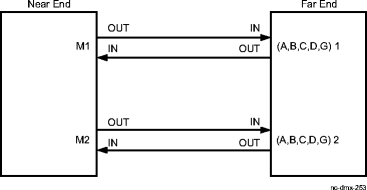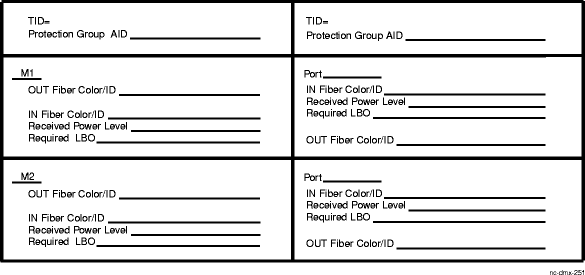Procedure 9-1.3: Establish high-speed 1+1 linear (Main-to-Function/Growth) network
Important!
This is not a standalone procedure. Perform this procedure only as directed by Procedure 9-1: Establish high-speed end-to-end Alcatel-Lucent 1665 DMXtend network.
Steps
Important!
This procedure assumes that the high-speed 1+1 linear network is established by interconnecting the OC-3/12/48 Main slot pair of the Alcatel-Lucent 1665 DMXtend to an OC-3/12/48 Function/Growth slot pair of another Alcatel-Lucent 1665 DMXtend. However, the OC-3/12/48 Main slot pair of the Alcatel-Lucent 1665 DMXtend may also be connected to an OC-3/12/48 Function/Growth slot pair of an Alcatel-Lucent 1665 DMX. If connecting to an Alcatel-Lucent 1665 DMX, refer to the Alcatel-Lucent 1665 Data Multiplexer (DMX) User Operations Guide, 365-372-301, as required, when performing this procedure.
This procedure assumes that the near-end node is the Main slot pair of an Alcatel-Lucent 1665 DMXtend and the far-end node is a Function/Growth slot pair of an Alcatel-Lucent 1665 DMXtendor Alcatel-Lucent 1665 DMX. Refer to the 1+1 linear worksheet at the end of this procedure when performing this procedure.
This procedure assumes that all Alcatel-Lucent 1665 DMXtend shelves have been equipped with the required circuit packs/pluggable transmission modules, software has been installed, and the shelf has passed the looped transmission tests. If not, refer to Chapter 5, Node turnup procedures.
Ignore all alarms until the procedure is complete.
Complete the following steps to establish a high-speed 1+1 linear (main-to-function/growth) network.
1 |
Important! There are two 1+1 configurations: Unidirectional 1+1 (referred to as 1+1) and Bidirectional 1+1. The port Application parameter must be provisioned 1+1 at both ends of the system or Bidirectional 1+1 at both ends of the system. Bidirectional 1+1 is required when interworking with other vendor's equipment that does not bridge DCC traffic on the active and standby lines. (Alcatel-Lucent 1665 DMXtend supports bridging DCC traffic on the active and standby lines.) From the System View menu at the near end node, select Configuration → Equipment to access the Main 1 and 2 ports and provision the port parameters according to the work instructions. Reference: Procedure 4-4: Provision OLIU circuit packs/ports for service Important! The port Application parameter may be changed from 1+1 to 1+1 Bidirectional or from 1+1 Bidirectional to 1+1 when cross-connections exist on the line pair. | ||||||
2 |
Select View → Equipment to access the Main 1 and 2 ports and verify that the ports were provisioned correctly. | ||||||
3 |
From the System View menu, select Configuration → Equipment. Select the Alcatel-Lucent 1665 DMXtend (AID=system), then click Select at the bottom of the window. If required, provision the 1+1 Protection Priority parameter (unidirectional 1+1 applications only). Click Apply if changes were made, then click Yes to the warning message to make your changes. Click Close to exit. | ||||||
4 |
Important! If OSI over DCC is enabled, the LAPD Role parameter must be provisioned differently at each end of an optical span. For example, if the LAPD Role parameter is provisioned to user-side at one end of an optical span, then the LAPD Role parameter must be provisioned network-side at the other end of the optical span. From the System View menu, select Configuration → DCC Terminations and provision the DCC terminations for DCC port dcc-m-1 according to the work instructions. Reference: Procedure 6-4: Provision DCC terminations | ||||||
5 |
From the System View menu, select View → DCC Terminations, verify that the DCC terminations were provisioned correctly for DCC port dcc-m-1, and click Close. | ||||||
6 |
Important! Synchronization Autoreconfiguration is only provisionable if the system Timing Mode parameter is Line and the Sync Messaging parameter of all ports is enabled. If the Sync Messaging parameter is enabled at any port in the network, it must be enabled at all ports in the network. If required, provision synchronization functions (for example, timing mode) according to work instructions. Reference: Procedure 6-5: Network Element synchronization provisioning | ||||||
7 |
Important! If Remote NE Status is to be used, at least one network element must be provisioned as the Alarm Gateway Network Element (AGNE) in the network. If the network element is designated as the Alarm Gateway Network Element (AGNE), the Alarm Gateway parameter must be provisioned Enabled. From the System View menu, select Administration → Set NE, provision the Remote NE Status, Alarm Group, and Alarm Gateway parameters according to the work instructions, and click OK. Result: A dialog box appears asking you to confirm executing this command. Click Yes. Reference: | ||||||
8 |
At the far-end node, provision the required Function/Growth ports and DCC terminations according to the work instructions.
| ||||||
9 |
Important! The near-end circuit pack in the Main 1 slot must be connected to the far-end circuit pack in the Alcatel-Lucent 1665 DMXtend Function slot D1 or G1, or the Alcatel-Lucent 1665 DMX Function/Growth slot A1, B1, C1, D1, G1. The near-end circuit pack in the Main 2 slot must be connected to the far-end circuit pack in the Alcatel-Lucent 1665 DMXtend Function slot D2 or G2, or the Alcatel-Lucent 1665 DMX Function/Growth slot A2, B2, C2, D2, G2. Refer to the 1+1 linear worksheet at the end of this procedure when connecting fibers. Connect the optical fibers and verify the integrity of the optical span being established. Reference: Procedure 14-4: Perform connection and verification of optical facility | ||||||
10 |
Perform end-to-end optical line test. Reference:
| ||||||
11 |
At each node in the 1+1 linear network, click the Alarm List button and verify that no alarms are present. If required, clear any alarms that are present. Reference: Alcatel-Lucent 1665 Data Multiplexer Extend (DMXtend) Alarm Messages and Trouble Clearing Guide, 365-372-326 | ||||||
12 |
Important! Establishing service requires that the proper slots in each terminating node be properly equipped with the correct circuit pack(s) for the type of service being established. It also requires numerous cross-connections in each of the nodes representing the path of the required service. Additionally, transmission tests should be performed to verify the continuity and quality of the established circuit. The 1+1 linear network is now ready for initial service to be established. Reference: End of steps |
1+1 Linear Worksheet (Main-to-Function/Growth)
Important!
A, B, C, D, and G (growth) are valid function slot pairs for Alcatel-Lucent 1665 DMX. D and G (growth) are valid function slot pairs for Alcatel-Lucent 1665 DMXtend.

